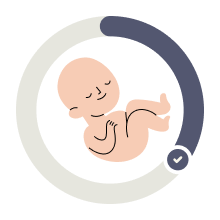As you approach week 14 of your pregnancy, you might start to feel more energetic and experience an overall improvement in your well-being. The good news is that your nausea may also be subsiding, bringing a sense of relief.
Additionally, as the risk of miscarriage significantly decreases by this time, you may start feeling less anxious. To learn more about the common queries, symptoms, and fetal development during week 14 of pregnancy, keep on reading.
Pregnancy Week 14 Quick Facts
- At 14th weeks, you’ve entered your fourth month of pregnancy
- You have 26 weeks until your due time “Calculate your due date”
- You’re in the second trimester
Your Unborn Baby’s Size at 14 Weeks
The weight of the fetus is approximately 42.5 grams, which is equivalent to 1.5 ounces, and its length measures about 8.68 centimeters, roughly the size of a peach.
Pregnancy Symptoms Week 14
Around the 14th week of pregnancy, it is typical to experience an increase in energy levels and a decrease in nausea. However, there is a possibility of encountering other symptoms that may emerge or resurface, including round ligament pain, lower back, or joint pain and cramps or charley horses in the legs, particularly at night.
Round ligament pain: During the 14th week of pregnancy, it is common for some expectant mothers to experience round ligament pain. This discomfort may manifest as sharp or shooting sensations in the lower abdomen or groin area.
The round ligaments are responsible for supporting the uterus, and as the uterus expands to accommodate the growing baby, these ligaments can be stretched, leading to discomfort or pain.
Cramps or charley horses in the legs: Leg cramps, also known as charley horses, are common during pregnancy, especially during the second and third trimesters.
To obtain relief, it is recommended to rest, lie down, stretches, massages, use warm compresses, take mineral supplements, and consume plenty of water or even take a simple walk.
Prenatal Tests and Doctor’s Appointments
NIPT, a non-invasive prenatal testing, can be ordered by some physicians at 14 weeks or in the previous three weeks to detect higher risks of chromosomal disorders such as Down syndrome and Trisomy 18. The decision to take the test or decline it should be made based on personal preferences and after discussing the potential benefits and risks with a healthcare provider.
If you had your last appointment with your healthcare provider at 10 weeks, you may have another appointment this week or in the next few weeks since appointments are typically scheduled four weeks apart during this stage.
During these appointments, the healthcare provider will use a Doppler, an external monitor, to listen for your baby’s heartbeat, which is a reassuring sign for both the medical team and the expectant parent.
– Risk in the 14th week of pregnancy
There is always a certain level of risk associated with pregnancy, and the 14th week is no exception. Here are some potential risks that may occur during the 14th week of pregnancy for both single and twin pregnancies:
Miscarriage
- While the risk of miscarriage decreases after the first trimester, there is still a small risk of miscarriage during the 14th week.
Birth defects
- Baby’s external genitalia is visible by 14-15 weeks, but may not be visible until 20 weeks.
Genetic disorders
- Certain genetic disorders, such as Down syndrome, may be detected during the nuchal translucency screening or blood tests.
Preterm labor
- Preterm labor is more common in twin pregnancies and may occur at any time during the pregnancy. However, the risk of preterm labor can be reduced with proper prenatal care.
Placenta problems
- Twin pregnancies have a higher risk of placenta problems, which can lead to complications such as bleeding, preterm labor, or fetal distress. To minimize the risks, it is important to attend all recommended prenatal appointments and tests, follow doctor’s advice, and maintain a healthy lifestyle.
Developmental Milestones
During this week of pregnancy, the baby’s neck becomes more defined, and red blood cells start forming in the spleen. At around this time, the baby’s sex becomes more apparent, although 90% of patients already know the sex from an earlier blood test. Baby’s external genitalia is visible by 14-15 weeks, but may not be visible until 20 weeks.
Organ development
- By the 14th week, many of the baby’s organs have formed, and they continue to mature and develop. This includes the heart, lungs, kidneys, liver, and digestive system.
Fetal movement
- By this stage, the baby’s muscles and nervous system are developing, and they may start making small movements. While these movements may not be noticeable to the mother yet, they are an important milestone in fetal development.
Skeleton development
- The baby’s bones are also continuing to develop and harden during the 14th week of pregnancy. This includes the formation of the skull, limbs, and other skeletal structures.
Nervous system development
- The baby’s nervous system is rapidly developing.
Sex determination
- The baby’s sex organs are more developed, and the baby’s sex may be visually determined through ultrasound.
For twin pregnancies
- Multiple fetuses may have different developmental milestones. Twins may be smaller in size at this stage, but their development is still on track.
Additionally, “twins may start interacting with each other by touching or holding hands during this stage of pregnancy.



